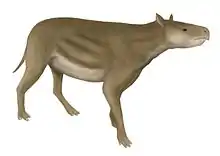| Heptodon Temporal range: Early Eocene | |
|---|---|
 | |
| Scientific classification | |
| Domain: | Eukaryota |
| Kingdom: | Animalia |
| Phylum: | Chordata |
| Class: | Mammalia |
| Order: | Perissodactyla |
| Superfamily: | Tapiroidea |
| Family: | †Helaletidae |
| Genus: | †Heptodon Cope 1882 |
| Species | |
| |
Heptodon is an extinct genus of tapir-type herbivore of the family Helaletidae endemic to North America during the Early Eocene. It lived from 50.3—48.6 mya, existing for approximately 1.7 million years.[1]
Heptodon was about 1 metre (3.3 ft) in length, and closely resembled modern tapirs. The shape of the skull suggests that it probably lacked the characteristic tapir trunk. Instead it probably had a slightly elongated, fleshy upper lip, like its relative Helaletes.[2]
See also
References
- ↑ Heptodon at fossilworks
- ↑ Palmer, D., ed. (1999). The Marshall Illustrated Encyclopedia of Dinosaurs and Prehistoric Animals. London: Marshall Editions. p. 261. ISBN 1-84028-152-9.
This article is issued from Wikipedia. The text is licensed under Creative Commons - Attribution - Sharealike. Additional terms may apply for the media files.